Did you know there are over 20 Parts of a Guitar? It also doesn’t matter how small each component is, as they all have a vital role in the tone and playability of your instrument!
Let us Jump straight into these with the image below…
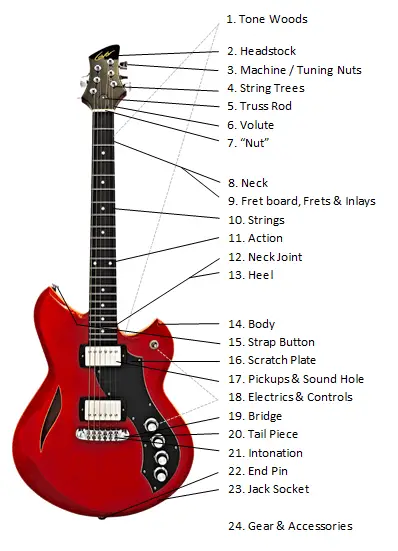
What are the guitar parts? There are over 20 parts that your guitar is made up of and these include Tone Woods, Headstock, Machine / Tuning Nuts, String Trees, Truss Rod, Volutes, Nut, Neck, Fretboard, Strings, Action, Neck Joint, Heel, Body, Strap Button, Scratch Plate, Pickups & Sound Hole, Electric & Controls, Bridge, Tail Piece, Intonation, End Pin and Jack Socket.
In this article, we cover each of these in so much detail… So, let’s jump right in!
1. Tonewoods
The first thing we need to cover is tonewoods as the majority of the parts of the guitar are made from at least one of these. Tonewoods are specialized woods that are used on many components of the guitar such as the Headstock, Neck, Fretboard, and body. Whereby, and ALL vary in density and grain. There are specific woods that we use because they carry a good sounding resonance and vary in tone (between mellowness and brightness) as well as being easy to manufacture.
The tonewood includes:
- Rosewood
- Mahogany
- Maple
- Wenge
- Koa
- Alder
- Basswood
- Swamp Ash
- Walnut
Tonewood Characteristics Chart
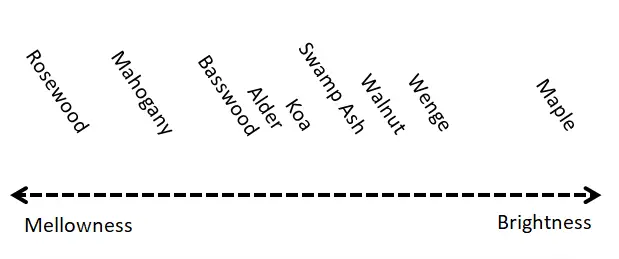
There are TWO factors, the density, and grain of the wood which suggest how bright or mellow the tonal output will be.
2. Head-Stock
At the top of the guitar, you will find the headstock. The headstock is at the end of the strings, where you tune your guitar. A headstock is the part of a guitar that helps anchor the guitar strings at the top end of the guitar. The headstock is the term that describes the part of the guitar that holds the tuning machine nuts (which are used to adjust the pitch of the guitar strings), Nut and Trust Rod.
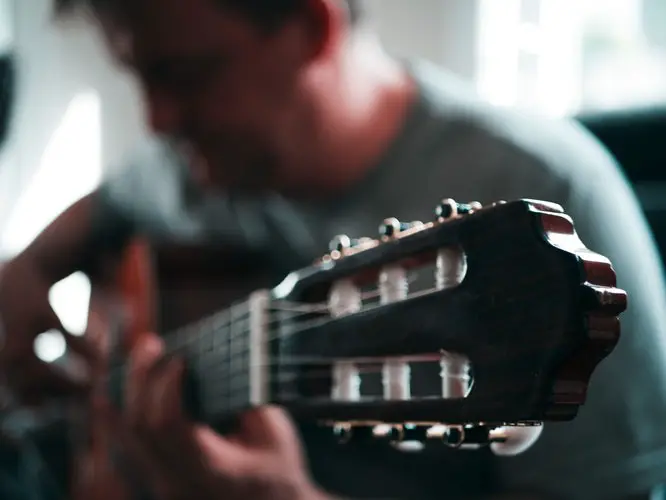
The headstock plays a vital role in how the guitar functions. The main function of a headstock is to provide stability. It is a solid foundation for firmly holding the machine heads under a high amount of tension at the top end of the guitar.
There are three Guitar Headstock Types that all serve a slightly different purpose. This includes the straight headstock, tiled back headstock, and the scarf headstock. In the image above you will see the straight headstock type.
that all serve a slightly different purpose. This includes the straight headstock, tiled back headstock, and the scarf headstock. In the image above you will see the straight headstock type.
3. Tuning Machine Heads
Tuning machine heads have many names. They are also known as Tuners, tuning machine nut , Tuning pegs, and Machine heads. This device is mounted on the head-stock and it is where you tune your guitar strings. Even though the tuning machine is very small, it is also very complicated in its design.
, Tuning pegs, and Machine heads. This device is mounted on the head-stock and it is where you tune your guitar strings. Even though the tuning machine is very small, it is also very complicated in its design.
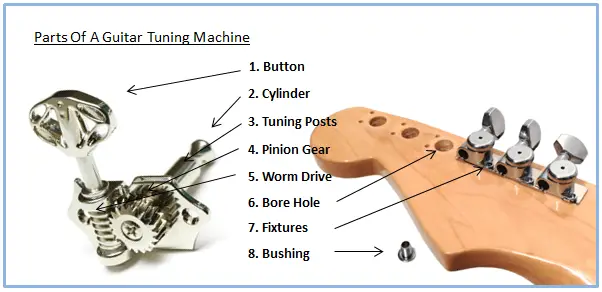
As you can see from the image above they are many components of a machine head to ensure it functions properly. Even though there are different machine head types
to ensure it functions properly. Even though there are different machine head types overall, they all work similarly. The flat, so-called button is attached to the post, which then leads to a gear that can be wound to tune the strings. The pitch of the strings can be adjusted by loosening or tightening the tension of the strings.
overall, they all work similarly. The flat, so-called button is attached to the post, which then leads to a gear that can be wound to tune the strings. The pitch of the strings can be adjusted by loosening or tightening the tension of the strings.
4. String Trees
The string trees are the component that fixes onto the headstock, hooking around the guitar strings. As you can see from the image below the String Tree is located between the Nut and the machine nuts.
is located between the Nut and the machine nuts.

String trees is an essential component for guitars with a straight headstock such as the traditional fender design. This is because string trees apply the necessary downward pressure on the strings increasing the tension making your guitar staying in tune much better!
5. Truss Rod!
Did you know that your guitar neck is prone to bending throughout the day? This is normal for any stringed instrument and this bending can be controlled by the truss rod! We do not see the truss because it is embedded in the guitar neck, which makes us take this simple construction for granted. But, you may be surprised to know that there are FOUR main Truss Rod Types.
However, we cannot forget that it is one of the most important parts of any guitar. As it is built right into the construction of the guitar means it can affect your tone and with careful adjustments, it can increase the feel and playability making your guitar much more comfortable to play.
6. Volutes

Volutes are an uncommon piece of construction but they add reinforcement to the headstock. So they can withstand more tension and an increased life span.
7. The “Nut”
At the point where the neck joins the headstock, the strings run over a small piece of material (wood, plastic, or sometimes other similar materials) that directs the strings across the fretboard. This is the Guitar Nut and the Guitar Nut Types are determined by the material they are made from!
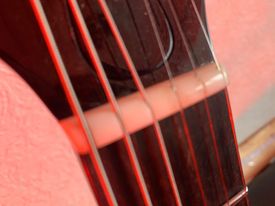
The Nut is a very commonly overlooked part of the guitar. Without a well-maintained and clean nut, the strings may not sit properly. This can have a direct effect on the tone of your instrument.
So, when you change your strings be sure to take a soft toothbrush and gently clean out the groove where the guitar sits.
8. Guitar Neck
The guitar neck is a long thin piece of wood that stems out of the guitar body. It is the part that you grip with your left hand (or the other one for left-handed individuals). The guitar neck is the location where you store the truss rod and holds the fretboard.
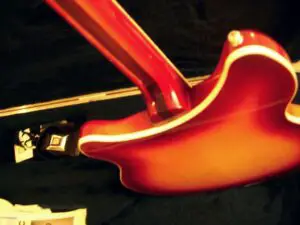
You may be surprised to know that there are THREE Guitar Neck Types, which all vary in shape. These include the U shape, V shape, and C shape.
9. Fingerboard/ Fretboard
The fretboard sits on top of the guitar neck; it is the long thin piece of wood that the strings run over. You press this and construct your notes with your left hand (with your left hand if right-handed, or right hand if left-handed).

There are also many Fretboard Types.  All vary in wood grain, however, the most common fretboard is made from maple, rosewood, and mahogany.
All vary in wood grain, however, the most common fretboard is made from maple, rosewood, and mahogany.
Frets
Frets are the raised bits of wire that can be observed along the width of the fretboards. Generally, it allows the player to find the exact notes easier without having to memorize the exact position of fretless instruments such as a violin.
Frets help with precision; fretless necks enable the player to play with the tones a lot more. Some guitars are fretless and many skilled guitarists especially jazz players prefer fretless.
Inlays
The inlays are ornamental markers set into the fretboard. The decoration may be simple as dots or customized depending on the owner’s taste. However, they indicate the 3rd, 5th, 7th, 9th, and 12th frets.
10. Strings
There are many Guitar Strings Construction methods and each method plays a vital role in the tone of the instrument.

Further, there are many “Guitars Strings Types” each sound very different but it’s a good idea to experiment to see which strings mold better with your guitar.
11. Action
Guitar action or guitar action height is the height of the guitar strings over the fretboard. Guitar action plays a big role in how a guitar feels to play.
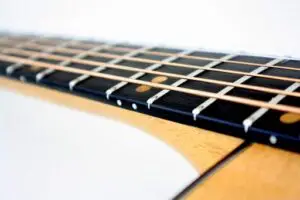
If the action is too high, the guitar will feel uncomfortable to play.
12. Neck Joint
There are three Neck Joint Types! This means the different techniques that the neck of the guitar and the body of the guitar are built in production.
But, depending on how all these parts are fixed together (mainly the neck and body) will have a direct effect on the tone your guitar will produce.
13. Heel
The production process to make a guitar is very complex and mostly done by hand. To make this process slightly easier the neck and body are produced separately and these parts will later be attached together. However, there are many techniques used to attach the neck and body (as discussed in the section above). Because of this reason, you will come across many Heel Types.
14. Body
Women have their curves, and so do guitars. The guitar body is the biggest part of a guitar and it is the part that holds the pickups and controls. It can also be illustrated as the curvy bits of a guitar, which sits upon your lap when you play.
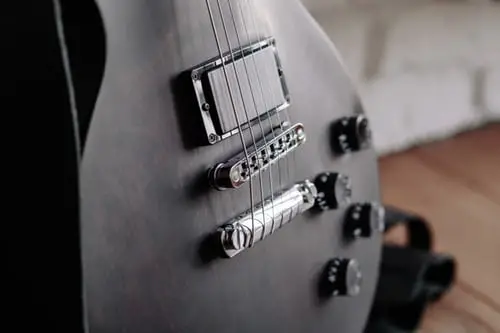
There are many Body Types. The larger the body the more bass the sound will have. A hollow body is quite well-known for acoustic guitars. Electric guitars can be hollow, semi-hollow or solid.
15. Strap Pin
The strap pin (also known as a strap button) is the component that you use to fix the guitar strap to your guitar so that you can use your guitar standing.
There are many Strap Pin Types available in the market. However, the most common is the traditional strap button.
16. Pick Guard / Scratch Plate
A Pickguard is also known as a scratchplate, finger rest and scratch guard and it is a thin laminated material that is positioned behind the strings on the body of a guitar.
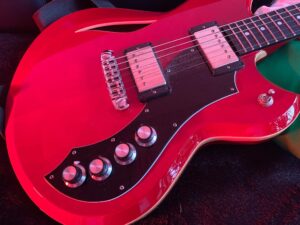
Plastic is a very common material that is used for a pick guard but you may also see other materials such as Plywood, Glass, Metal & Acrylics. Moreover, any material can be used; in some rarer cases even exotic woods, fur, gold, silver, abalone pearl, and even gems are used.
17. Pickups & Soundholes
Pickups & the sound hole is covered. Both of these components are responsible for amplifying sound out of your instrument. Pickups appear on electric or electro-acoustic guitars. They are small rectangular blocks located on the body of the guitar under the strings.
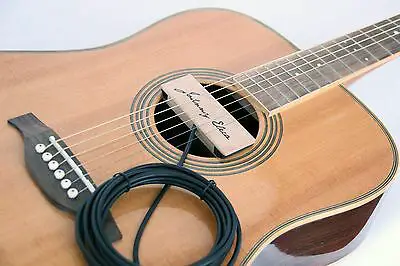
They contain coils and magnets to capture the sound the guitar produces and is sent through an amplifier. Sound holes only appear on acoustics, under the string on the body of the guitar.
18. Electrics & Controls
Pickup Selector Switch
Unlike acoustic guitar, electric ones usually have more than a single pickup. You will swap between these pickups using a “Pickup selector switch”. Because the strings have a different tone at different positions, so multiple pickups can allow for different tones. In addition, different pickup types have different tones as well. In order to swap between those, a selector switch should be allowed.
Volume, Tone & Controls
These are designed in the form of knobs on a guitar body, near the pickups. There also various wiring configurations (separate controls or not, for example), but put simply. Volume knobs control the level of signal coming from the pickups, and tone controls adjust how bright that signal is.
To learn about these in greater detail, please visit Electric & Controls
19. Bridge
The bridge is located on the guitar body and is used to position the guitar strings as they travel past the pickups/soundhole towards the fretboard.
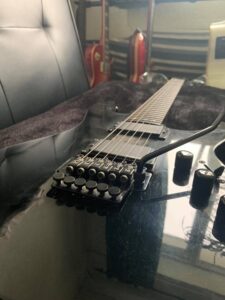
There are SEVEN Guitar Bridge Types which can be further subcategorized into either floating bridges or a fixed bridge.
Saddle
Saddles are built into the bridge and they’re the component opposite of the nut where the string leans on the body of the guitar. On an electric guitar, it’s common for these to be individual to each string in order for them to be adjustable solely if needed.
The saddle tends to be a single, notched piece of material on an acoustic guitar, very similar to a nut.
The maintenance for saddles is similar to that of the nut.
20. Tailpiece
The tailpiece is usually known for sitting behind the bridge. However, people also refer to the part of the bridge where you rest your palm as the tailpiece.
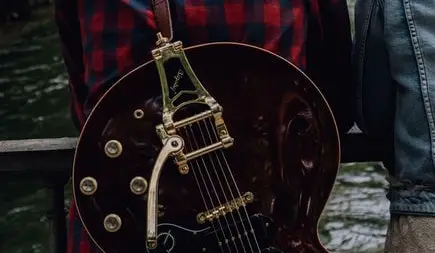
There are many Tail Piece Types however, they all have the same function. The strings need to be anchored at both ends, otherwise, they’d just sort of flop around. At the headstock, the strings are secured on the tuners. At the body, the guitar strings attached to the tailpiece on the bridge.
Some tailpieces are very large for aesthetic reasons as seen in the above image.21. Intonation
Intonation is the terminology we use to describe the accuracy of the pitch along the fretboard. Once you tune your guitar the pitch accuracy can go flat or sharp as you play down to the 12th fret. This happens because the tension of the string is not accurately balanced and the pitch will get worse the further you go down the fretboard.For example, when you tune your guitar you pluck the open (unfretted) strings which will hold the accurate pitch. However, when you fret on the 12th fret, the tension of the string increases slightly, which bends the pitch of the note slightly upward.
Overall, if the tension is not set right then it can affect the whole tuning of your guitar. Furthermore, the adjustments of the tension are very subtle, but the consequence of this happening can severely influence the accuracy of the notes and dissonant chords.
22. End Pin
If you have ever played the guitar stood up then you will be familiar with the guitars “endpin”. If you are struggling to find the attachment that fixes the guitar strap to your guitar then you will need to know about the endpin.
An “endpin” is a small ‘knob-like’ component on a guitar that attaches the guitar strap to the guitar, located at the tail end of the guitar. It is used to hold the guitar strap so you can play stood up.
23. Jack Socket
The jack socket is a connector that connects the jack lead (coming from the amplifier) to the guitar.
Conclusion
In almost every guitar course, the first lesson would be an introduction to the parts of a guitar. It is important to understand the pieces that make up the instrument you are playing because this directly affects the tone you are looking for.
In this article, we covered all of the components you will find on a guitar to give you a quick and basic understanding of what you’re up against if you’re having problems. I have also linked each section to the article where I discuss each component in grave detail.
If you liked this article and you feel it helped you then please leave a comment and share it on social media. I am actively updating these articles daily and so I will see any comments made within a few days of posting!
Thank you so much and have a great day!


Good info. Lucky me I reach on your website by accident, I bookmarked it.
Wonderful site. Lots of useful info here. Thanks for your hard work!
Wow, fantastic blog layout! How long have you been blogging for? you make blogging look easy. The overall look of your site is magnificent, as well as the content!
Great info, thanks! Btw, what is that beauty in the picture and what color…?